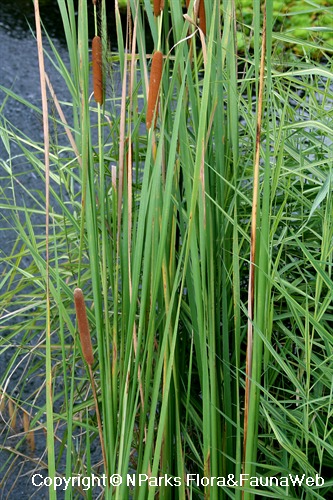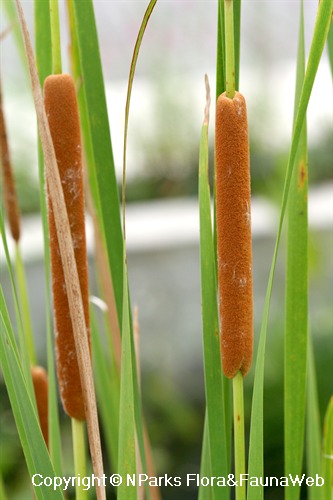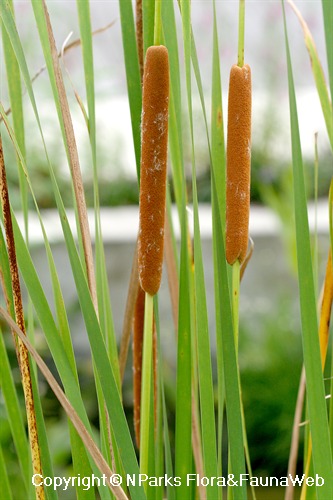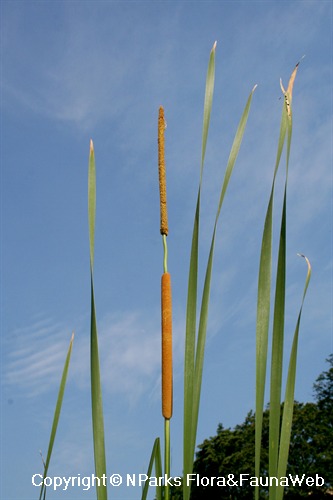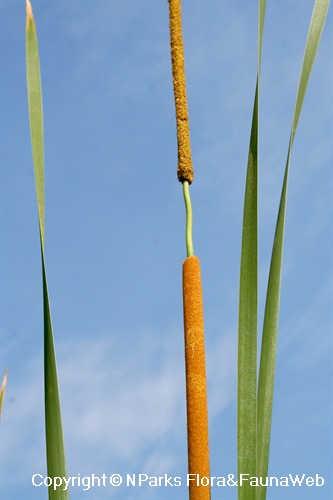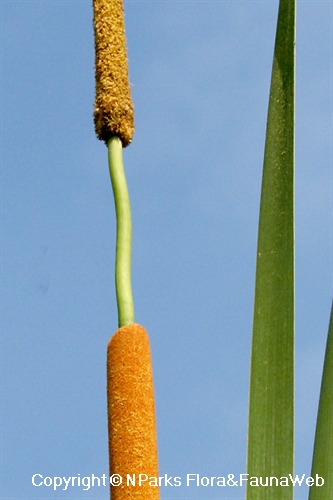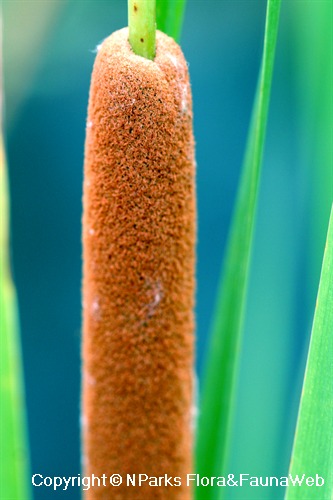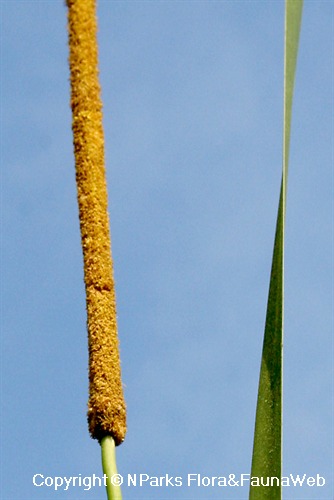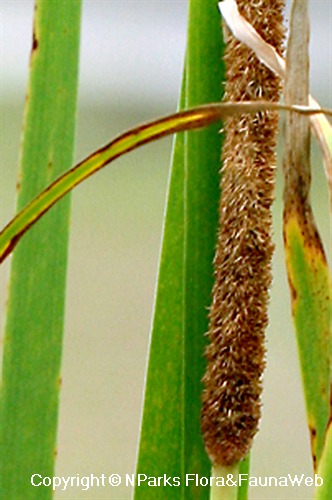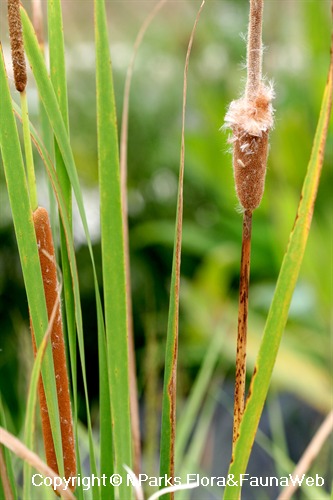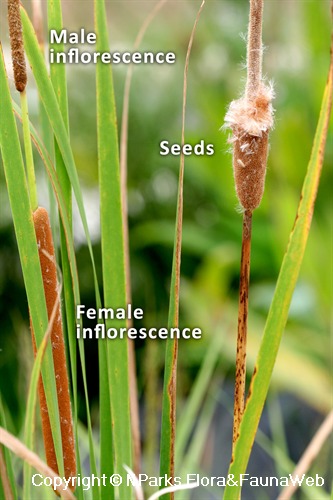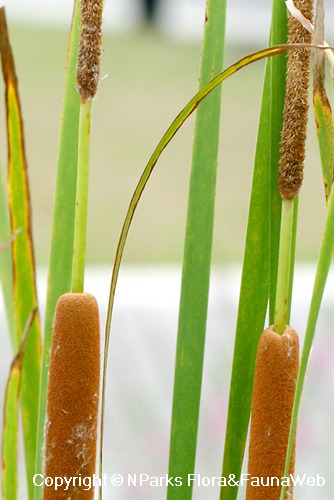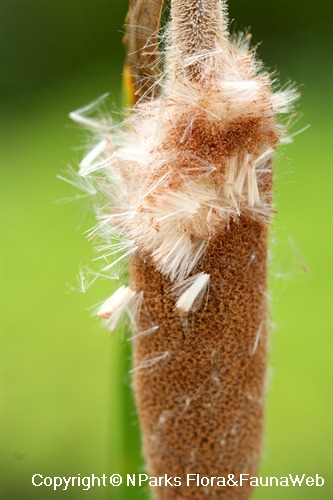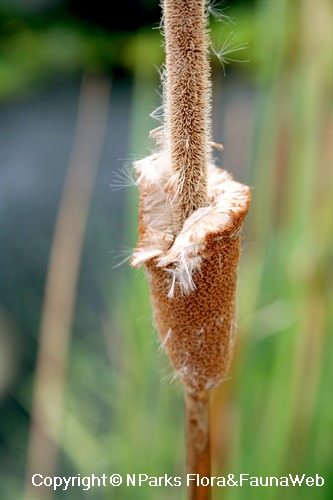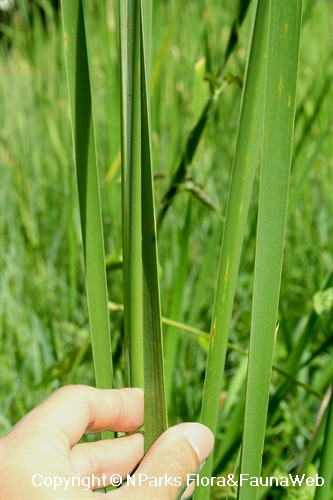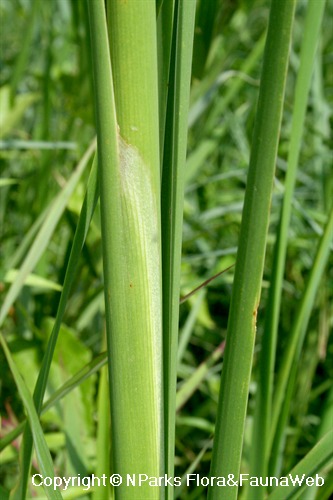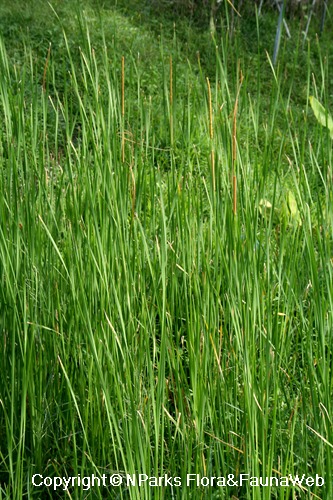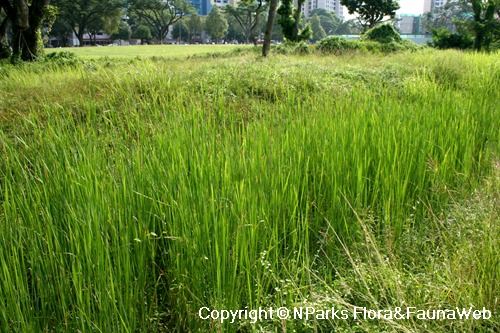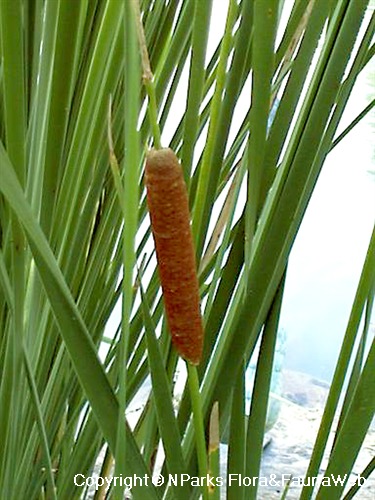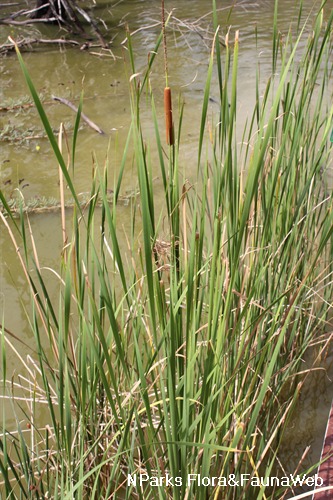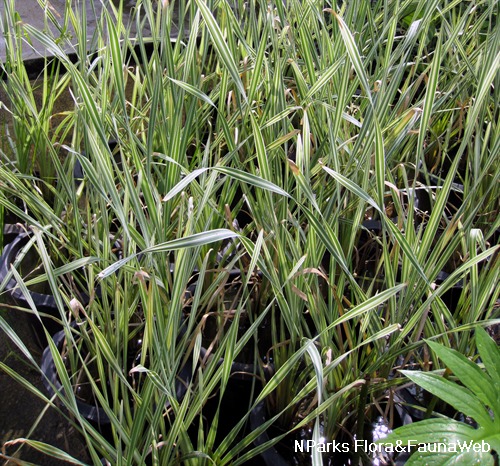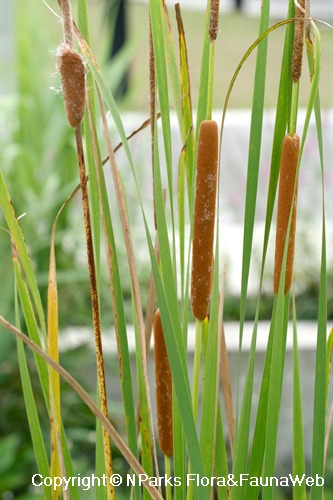
Back
Typha angustifolia L.
| Family Name: | Typhaceae |
| Synonyms: | Massula angustifolia (L.), Typha minor Curtis, Typha augustata Bory & Chaub. |
| Common Name: | Narrowleaf Cattail, Soft Flag, Lesser Bulrush, Narrow-leaf Reedmace, Nail-rod, Banat, 水烛, 蒲黄, 狭叶香蒲 |
Typha angustifolia, commonly known as the Narrowleaf Cattail, is an emergent aquatic plant up to 2 m tall with linear, erect leaves and brown, rod-shaped inflorescences. The fluff from the seeds is used as nesting material by various birds including the Scarlet-backed Flowerpecker (Dicaeum cruentatum) and several sunbird species. In a wetland constructed by researchers in Singapore, the Narrowleaf Cattail was found to perform phytoremediation services; accumulating pollutants from the water in its plants’ tissues.
Name
Classifications and Characteristics
| Plant Division | Angiosperms (Flowering Seed Plants) (Monocotyledon) |
|---|---|
| Plant Growth Form | Aquatic & Hydrophyte (Emergent Aquatic, Waterside / Marginal), Herbaceous Plant |
| Lifespan (in Singapore) | Perennial |
| Mode of Nutrition | Autotrophic |
| Maximum Height | 1.5 m to 3 m |
Biogeography
| Native Distribution | North America, Northwestern Africa (Morocco & Algeria), Europe, Central Asia, India, Nepal, West Himalaya, Western & Central Russia, Mongolia, China, Korea, & Japan. |
|---|---|
| Native Habitat | Terrestrial (Riverine), Aquatic (Freshwater Pond / Lake / River) |
| Preferred Climate Zone | Temperate |
| Local Conservation Status | Non-native (Spontaneous (Naturalised)) |
Description and Ethnobotany
| Growth Form | A perennial herbaceous marsh plant with an underground creeping rhizome. |
|---|---|
| Foliage | Its thick narrow sword-shaped leaves grow in tufts of eight to ten, standing erect above the water at 1-3 m in length. |
| Flowers | Flowering stems stand at 1.5-2 m tall, bearing cylindrical terminal spike inflorescences that are 25-50 cm long. Inflorescences are monoecious, each consist of an upper male part that is brownish in colour and a lower female part is dark brown in colour. |
| Fruit | Fruits are about 5-8 mm long, with bristly white hairs arising from the middle, which aid in the dispersal of the fruits by wind. |
| Habitat | It can be found throughout the northern hemisphere. In Singapore, this naturalised species occurs in shallow open marshes and was previously more commonly found in many stagnent pools or other water bodis in open fields, reclaimed land and construction sites. |
| Associated Flora | T. angustifolia can be found occurring together with T. latifolia where both species naturally hybridises as Typha x glauca. |
| Associated Fauna | The seed fluff is used as nesting material for birds such as the Scarlet-backed Flowerpecker (Dicaeum cruentatum) and some sunbird species. Stems and roots are eaten by geese. The tufts of leaves extending above the water also provide shelter for water birds. |
| Etymology | The genus Typha is possiblly derived from Greek typhos "marsh" or typhe "cat's tail", which the plant's inflorescence resembles. The specific epithet angustifolia is from Latin meaning "narrow-leafed". |
| Ethnobotanical Uses | Edible Plant Parts : Edible Fruits, Edible Leaves, Edible Flowers, Edible Stems, Edible Seeds Food (Fruit or Vegetable): Several parts of the plant are edible when gathered at the right stage. One of these is the rhizomatous stem, known as bồn bồn in Vietnam, which is fairly high in starch content and processed into flour. The base of the stem, where it is attached to the rhizome may be boiled or roasted like potatoes. Bases of the leaves can be eaten raw when young and tender, and also cooked. Flower stalks may be harvested and eaten like corn cobs. Bright yellow or green in colour, the pollen from mature flowers may be used as a thickener or used in place of flour to make pancakes and cookies which take on the same bright colour. Medicinal: Roots have been known to be boiled and used to treat skin conditions and as a diuretic. Others: The fluffy seeds can be used as stuffing for bedding and pillows, but might cause allergic reactions, like skin irritation and asthma. The plant is used in phytoremediation to remove pollutants from the water. |
Landscaping Features
| Desirable Plant Features | Ornamental Flowers, Ornamental Fruits, Ornamental Seeds |
|---|---|
| Landscape Uses | Riverine, Phytoremediation (Ground / Water Contaminant(s)) |
| Thematic Landscaping | Water Garden, Naturalistic Garden |
| Usage Hazard - Cons | Invasive / Potentially Invasive, Irritant - Nasal Allergy |
| Plant & Rootzone Preference or Tolerance Remarks | pH 3.7 - 8.5 |
Fauna, Pollination and Dispersal
| Fauna Pollination Dispersal Associated Fauna | Bird-Attracting |
|---|---|
| Pollination Method(s) | Abiotic (Wind) |
| Seed or Spore Dispersal | Abiotic |
Plant Care and Propagation
| Light Preference | Full Sun |
|---|---|
| Water Preference | Lots of Water |
| Plant Growth Rate | Fast |
| Rootzone Tolerance | Fertile Loamy Soils, Waterlogged Soils (Drains Site), Acidic (low pH) Soils, Alkaline high pH Soils |
| Maintenance Requirements | Moderate |
| Propagation Method | Seed, Storage Organ, Division |
Foliar
| Foliage Retention | Evergreen |
|---|---|
| Mature Foliage Colour(s) | Green |
| Mature Foliage Texture(s) | Smooth, Thick |
| Foliar Type | Simple / Unifoliate |
| Foliar Shape(s) | Non-Palm Foliage (Lanceolate) |
| Foliar Venation | Parallel |
| Foliar Margin | Entire |
Non - Foliar and Storage
| Stem Type & Modification | Acaulescent |
|---|---|
| Root Type | Underground (Fibrous Root) |
| Specialised Storage Organ(s) | Underground (Rhizome) |
Floral (Angiosperm)
| Flower & Plant Sexuality | Unisexual Flowers , Monoecious |
| Flower Colour(s) | Brown, Green |
|---|
| Flower Size - Remarks | Staminate (male) spikes separated from pistillate (female) spike by 1.2 -12.5 cm of naked axis, ca. as long as pistillate, 1 cm thick in anthesis. |
| Inflorescence Type | Spike |
| Flowering Period | Free-Flowering |
| Flowering Habit | Polycarpic |
Fruit, Seed and Spore
| Mature Fruit Colour(s) | Brown |
|---|---|
| Fruit Classification | Simple Fruit |
| Fruit Type | Indehiscent Dry Fruit , Achene |
References
| References | B.C. Conservation Data Centre. 2020. Species Summary: Typha angustifolia. B.C. Minist. of Environment. Available: https://a100.gov.bc.ca/pub/eswp/ (accessed Nov 2, 2024).
Leong-Škorničková, J. (2019). Typhaceae. In Flora of Singapore, Volume 7 (pp. 1–5). National Parks Board (NParks). |
|---|
Image Repository
Others
| Master ID | 1243 |
|---|---|
| Species ID | 2536 |
| Flora Disclaimer | The information in this website has been compiled from reliable sources, such as reference works on medicinal plants. It is not a substitute for medical advice or treatment and NParks does not purport to provide any medical advice. Readers should always consult his/her physician before using or consuming a plant for medicinal purposes. |


